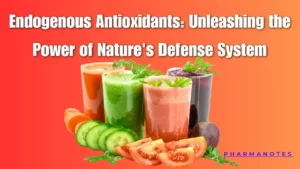Endogenous Antioxidants: Unleashing the Power of Nature’s Defense System

Endogenous Antioxidants
Endogenous antioxidants are the body’s natural defense system against oxidative stress. They can be categorized into enzymatic and non-enzymatic antioxidants.
Enzymatic antioxidants include superoxide dismutase (SOD), which converts superoxide radicals into less harmful hydrogen peroxide; catalase, which breaks down hydrogen peroxide into water and oxygen; and glutathione peroxidase, which uses glutathione to reduce hydrogen peroxide and lipid peroxides.
Non-enzymatic antioxidants include glutathione, often referred to as the “master antioxidant,” which directly scavenges free radicals and regenerates other antioxidants like vitamins C and E. Vitamin C is a water-soluble antioxidant that neutralizes free radicals in both watery and fatty environments and supports the immune system. Vitamin E, a fat-soluble antioxidant, protects cell membranes from oxidative damage and regenerates other antioxidants.
These endogenous antioxidants work synergistically to maintain the delicate balance between free radicals and antioxidants in the body, preventing oxidative damage and promoting overall health and well-being.
Enzymatic Antioxidants:
Enzymatic antioxidants form the frontline defense against oxidative stress within our cells. One key player is superoxide dismutase (SOD), which catalyzes the conversion of superoxide radicals into less harmful hydrogen peroxide. It exists in different forms, including SOD1, SOD2, and SOD3, each localized in specific cellular compartments. SOD ensures the delicate balance between free radicals and antioxidants.
Catalase is another critical enzymatic antioxidant found primarily in peroxisomes. It rapidly breaks down hydrogen peroxide, a byproduct of SOD activity, into water and oxygen, preventing the accumulation of this potentially harmful molecule.
Glutathione peroxidase is an enzyme that works alongside SOD and catalase to neutralize a wide range of free radicals. It utilizes glutathione, a powerful non-enzymatic antioxidant, to reduce hydrogen peroxide and lipid peroxides. Glutathione peroxidase acts as a critical defense mechanism against oxidative damage.
Non-enzymatic Antioxidants:
Glutathione, often referred to as the “master antioxidant,” is a tripeptide composed of cysteine, glutamic acid, and glycine. It is present in every cell and helps maintain the redox balance. Glutathione acts as a primary defense against oxidative stress by directly scavenging free radicals and regenerating other antioxidants, including vitamins C and E. It also aids in the detoxification of harmful compounds in the body.
Vitamin C, or ascorbic acid, is a water-soluble antioxidant found in various fruits and vegetables. It plays a crucial role in neutralizing free radicals in both watery and fatty environments. Vitamin C regenerates oxidized vitamin E, enhancing its effectiveness. Additionally, it supports the immune system and helps in collagen synthesis.
Vitamin E encompasses a group of fat-soluble compounds, including tocopherols and tocotrienols. It primarily protects cell membranes from oxidative damage by intercepting free radicals and breaking the chain reaction of lipid peroxidation. Vitamin E also regenerates other antioxidants, such as vitamin C.
α-lipoic acid is a versatile antioxidant that can regenerate other antioxidants like vitamins C and E. It has the unique ability to function in both water and lipid environments, allowing it to scavenge free radicals throughout the body. α-lipoic acid also enhances the effectiveness of other antioxidants, making it a potent defender against oxidative stress.
Melatonin, primarily known for its role in regulating sleep-wake cycles, also possesses significant antioxidant properties. It scavenges free radicals, including hydroxyl radicals and peroxynitrite, and protects cells from oxidative damage. Melatonin’s antioxidant effects extend to various organs and tissues, contributing to overall health and well-being.
Conclusion:
Endogenous antioxidants form an indispensable defense system within our bodies, combating the damaging effects of oxidative stress.
Enzymatic antioxidants, such as superoxide dismutase, catalase, and glutathione peroxidase, work synergistically to neutralize free radicals and prevent cellular damage.
Non-enzymatic antioxidants, including glutathione, vitamins C and E, α-lipoic acid, and melatonin, provide additional support by scavenging free radicals, regenerating other antioxidants, and maintaining the delicate redox balance.
By understanding the importance of endogenous antioxidants and incorporating lifestyle practices that promote their products, such as a healthy diet rich in fruits, vegetables, and whole grains, regular exercise, and adequate sleep, we can optimize our body’s natural defense system. Let us embrace the power of endogenous antioxidants and strive for a healthier, more resilient future.
Also, Visit: Dietary Supplements and Nutraceutical
Functional Food for Chronic Disease Prevention PDF
Endogenous Antioxidants Enzymatic and Non-Enzymatic Defenses